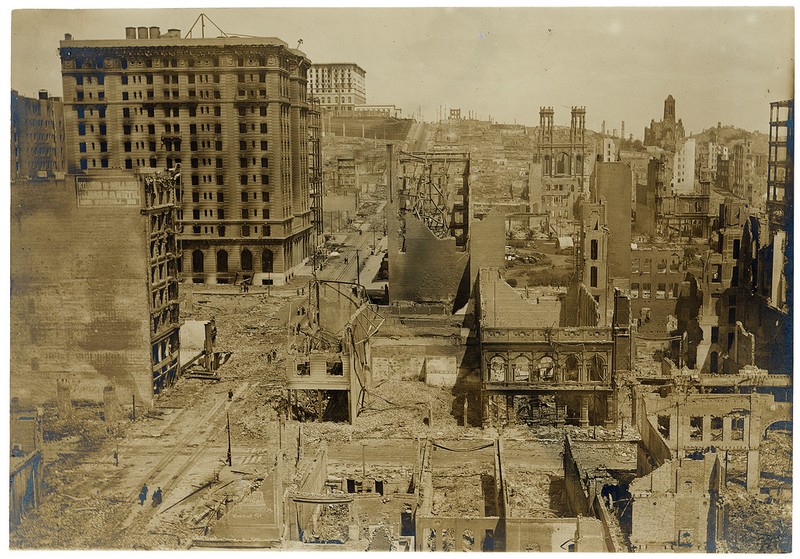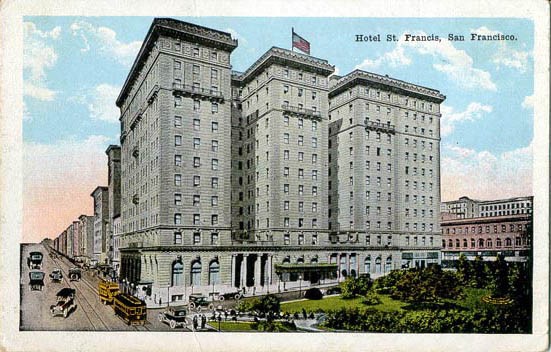St. Francis Hotel
Introduction
Text-to-speech Audio
Few hotels can boast the storied history of the St. Francis. Built in 1904, the hotel survived the 1906 earthquake but was gutted by a resulting fire. The hotel's main clock has been a landmark almost from the beginning, with generations of San Francisco residents and visitors, and the hotel has hosted numerous celebrities and other luminaries. The hotel has also witnessed its share of tragedies and a few scandals throughout its long existence. The hotel became part of the Western Hotels chain in the 1950s and is now the Westin St. Francis.
Images
Modern view of St. Francis Hotel, with 1972 tower addition in back (Westin St. Francis. Eric Molina 2008)

Circa 1904 photo of original portion of St. Francis Hotel, adjacent to Union Square (Wells Fargo Bank History Room, S. F.)

The St. Francis (upper left) following the 1906 earthquake

The St. Francis as it appeared by the mid-1910s to 1920s in a postcard image

St. Francis Hotel photographed circa 1913 for a S. F. visitors guidebook (Todd 1914 p. 40)

Illuminated facade of St. Francis Hotel in 2016 nighttime image (Dllu)

Backstory and Context
Text-to-speech Audio
The St. Francis Hotel has been an integral part of San Francisco's culture and lore since it opened its doors on March 24, 1904. The hotel was built by the estate of millionaire Charles Crocker as an investment for his heirs. They envisioned San Francisco as the "Paris of the West" and studied grand hotels in the major European cities for inspiration. The original hotel--two twelve-story towers--opened in 1904, for $2.5 million.
The hotel was immediately popular and became a hub of the city's artistic and literary life. Two years after it opened, however, San Francisco was devastated by the 1906 earthquake. The building's structure withstood the earthquake, but the ensuing fire destroyed the hotel's interior. The hotel reopened in late 1907, and the Great Magenta clock that controlled all of the other clocks in the building was placed in the lobby to mark the event. For more than a century, San Franciscans have told each other, "Meet me at the clock."
Another wing was added to the hotel in 1908, and a fourth wing was constructed between 1913 and 1914. These additions made this the largest hotel on the West Coast at that time. In 1913, the 1,000 rooms in St. Francis rented for $2.00 per day and up. In the 1910s and 1920s, the St. Francis became one of the most fashionable hotels in the city, with a large following among celebrities and public figures. Among the hotel's many notable guests were President Woodrow Wilson, former president Theodore Roosevelt, Douglas Fairbanks, Charlie Chaplin, Tom Mix, Cecil B. DeMille, and many others. According to legend, John Barrymore was in bed with a female guest at the time of the 1906 earthquake but initially attributed the rumbling and swaying walls to passion. Victor Hirtzler served as head chef at the St. Francis from 1904 to 1926. Hirtzler's food was known for its French influences and his flair for presentation. He created The Hotel St. Francis Cook Book (1919), sharing recipes and cooking advice.
If famous guests were a boon for the hotel, they also occasionally came with a cost. One of Hollywood's first major scandals arose from an incident at the St. Francis in 1921. Comedian Roscoe "Fatty" Arbuckle threw a Labor Day party in a suite of rooms at the hotel. Arbuckle summoned a doctor to his room to report that a young woman, Virginia Rappe, was ill. The young actress died days later, and a friend of hers claimed that Arbuckle raped the woman. Her testimony was considered unreliable, and Arbuckle was tried three times; the first two trials resulted in a hung jury, and he was acquitted in the third trial. The scandal did lasting damage to Arbuckle, however, and his career never recovered. The singer and performer Al Jolson died of a heart attack in 1950, in the same suite of rooms made infamous by Fatty Arbuckle.
The St. Francis was nearly the site of another famous death in 1975, when a woman named Sara Jane Moore fired two shots at President Gerald Ford as he exited the hotel. A bystander, who happened to be a former Marine, grabbed Moore's arm as she fired the second time, possibly saving Ford's life. In 1972, a 32-story tower was added to the St. Francis, making the hotel one of the largest in the city.
Cite This Entry
Paonessa, Laurie, Rebecca Woodham, and Clio Admin. "St. Francis Hotel ." Clio: Your Guide to History. July 3, 2025. Accessed August 1, 2025. https://theclio.com/entry/37932
Sources
Gubler, Fritz. Glynn, Raewyn. Great, Grand & Famous Hotels. Crows Nest, New South Wales, Australia. Great, Grand & Famous Pty Ltd, 2008.
Hirtzler, Victor. The Hotel St. Francis Cook Book. Edition Reprint of 1919. Creative Media Publishers, LLC, 2015.
Westin St. Francis. "Our History". January 1st, 2010. Accessed April 25th, 2017.
Westin St. Francis. "Hotel History." Accessed June 23rd, 2015. https://www.marriott.com/en-us/hotels/sfouw-the-westin-st-francis-san-francisco-on-union-square/overview/.
https://en.wikipedia.org/wiki/Westin_St._Francis#/media/File:Westin_st_francis_san_francisco.jpg
https://en.wikipedia.org/wiki/Westin_St._Francis#/media/File:St._Francis_Hotel_San_Francisco_1904.jpg
The Chamber of Commerce Handbook for San Francisco, San Francisco Chamber of Commerce 1914
https://en.wikipedia.org/wiki/Westin_St._Francis#/media/File:Westin_St_Francis,_nighttime,_September_2016.jpg
